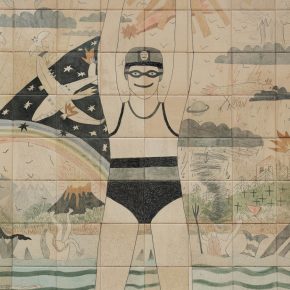Studio conversation with studio holder Jack Brindley
You work with glass.
Yes, Im trying to understand how these enamels work. Silver stain makes a yellow colour to the glass and I’m just experimenting now with screen printing onto the glass because traditionally it’s brushed on. I’d like to achieve a much flatter, more dense coverage.
Most of my current work is in glass, Which is a relatively recent development I have not always worked with glass. My last set of commissions all followed on from one another and now I’m gradually turning into the ‘glass guy’. Most of the things that I produce are site specific. These are drawings for a window in Cambridge, England, and it’s quite large, it’s going to be 5 metres tall.
You get the pattern and colour through enamelling.
Well, there’s lots of different ways. One could be cutting different colours of glass and which can be assembled together, traditionally with lead. But I’ve been using a lot of silicon bonding techniques recently, which means that you can work at a large scale and not have to have all the other complications that lead brings with it, so that’s one option. Another option is Flashed Glass, where clear glass is made with a very thin layer of coloured glass applied on to it; you can etch away the coloured glass and reveal the clear glass behind. And then the other method is enamelling.

This is what you explore now.
Yeah, exactly. The beauty of working with enamels is that you can work as large as your kiln size, and then, if you need to, you could potentially collage pieces together using this silicon bonding technique. At the moment it’s kind of at the research heavy stage trying to figure out exactly what are the best sort of processes to take forward. And I suppose a lot of my work is following the materials at hand, so when a process becomes available, I look to use the qualities that come with those processes to show the material to its best advantage rather than trying to kind of wrestle it into submission.
I’m working very much project to project. So when something comes through, there’s the buildup stage where you have to propose what you’d like to do and how that might look. And that’s what I’m running through now. I was intrigued by glass as a material and pursued it, well, I don’t think I pursued it in a very serious sense, more as a hobbyist might pick up another material, thinking what benefits it could bring to a practice, and, quite quickly, people started asking me to make windows. And then it snowballed into this larger thing, and somehow, I’m in this position now.
When I started to produce the glass work, I did so under an alias, ‘Pavilion Pavilion’, so a different name to my own, as a way to give license to making a different sort of work. And it was always my intention for it to be entirely separate. But the longer I spend working with the material, it has slowly become my practice.
So, I guess when I get this to some sort of stage of completion, I’d like to pursue making more glass objects as a learning process to figure out where they are in the world. Often, between projects I find myself going back to drawing and painting. Accumulating masses and masses of bits of paper, essentially and then from there it can become many different things. Sculpture always begins with 2D for me, a lot of thinking, nothing figurative.
Abstract painting.
Abstract in the sense that there’s not a literal representation, but a lot of my practice has had a conceptual underpinning. There will be an idea which in turn I use materials to explore, particularly with glass because it’s such a seductive material, that relies heavily on perception. It would seem a little bit unjust to start pinning lots of other overblown ideas onto it, when the inherent qualities of glass – light and space -they’re quite big themes anyway. So it becomes a formal work in as much as you’re playing with those things and not trying to be too heavy-handed in putting other kinds of objective meanings onto the work.
I think that’s why I’ve produced this work under a different name, so it doesn’t cloud up my sometimes conflicting intentions as an artist. I think this is connected to my thinking about a cohesive approach and what it meant to put forward another way of working, a different name is a very liberating way to make work in a new field.

Do you have any recurrent themes in your mind?
I’ve been really obsessed by Robert Irwin and particularly his trajectory as an artist going from hard edged, minimalist painting through to making environments. Well, I guess the artwork generally dissolves and it becomes a kind of stage making device. A proposition about perception in general. This led me to think about how prisms operate and how light can be used to create a lens to a space but is also used to project images.
You haven’t mentioned wood and I think you have a good relationship with wood as well.
Yeah, I have made furniture in the past. Wood is such a brilliantly easy material, it’s so ubiquitous and you can chop it up and glue it and do all these things, it’s very malleable. Glass is the opposite, it’s really stubborn. There’s a combination of materials in my sculptural work. When glass is not an architectural thing, it’s not a window, as the one I am making now, I find the display of it can be slightly problematic, and how do you deal with that? That’s where wood and steel currently come in and makes sense of it.
Studio conversation with studio holder Jack Brindley , March 2023
You can also read about Jack’s work on his Pavilion Pavilion website pavilionpavilion.com




